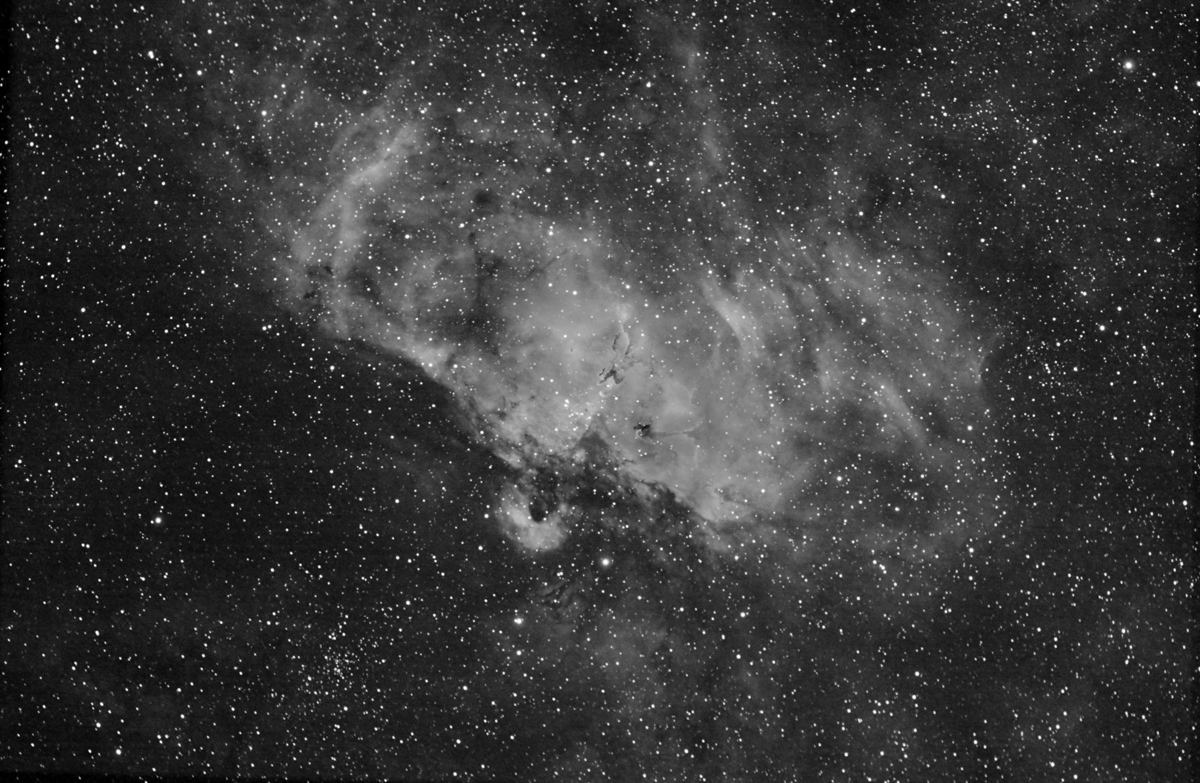
|
La nebulosa Aquila - M16 (NGC
6611) The Eagle nebula - M16 (NGC 6611) A.R. 18h18m48s - Decl. -13░47'00" Immagine al massimo dettaglio (200%) - Image at 200% |
|
Questa foto della nebulosa Aquila (NGC 6611),
conosciuta anche come M 16, visibile nella costellazione del
Serpente,
Ŕ stata scattata il 9 e 10 luglio 2010 dal cortile della mia
casa ad Arcidosso (GR) al
fuoco diretto di un telescopio Takahashi TSA102 ridotto a f/6.3 su
montatura Gemini G41 Obs con FS2. La foto Ŕ la somma di 24 esposizioni da 12 minuti cadauna, con una fotocamera digitale Canon Eos 40D con filtro modificato, usando un filtro Ha Eos-Clip da 13 nm, settato a 800 ISO che sono state effettuate con inseguimento mediante rifrattore 120/600 in parallelo e autoguida Atik 16IC. La temperatura esterna era di 22░ ma con un prototipo di cold box da me realizzato ho operato a temperature di circa 10░ pi¨ basse costantemente. Successivamente i frames sono stati calibrati con DeepSkyStacker utilizzando 25 dark, 42 flat, 42 dark dei flat e 42 bias. I files sono poi stati sommati con Registar. E' stato elaborato il segnale di luminanza utilizzando solo il canale R dell'immagine risultante. E' stato applicato uno stretching, maschera sfocata, deconvoluzione e riduzione del rumore. Nella tabella sottostante sono riportati i valori di temperatura, umiditÓ e brillanza del cielo nella zona ripresa (usando lo SQM-L) a vari orari. This photo of the Eagle Nebula (NGC 6611), also known as M 16, in Serpens Caput, was taken on july 9 and 10, 2010 from the backyard of my home in Arcidosso, in Italy, near Grosseto, at the prime focus of a Takahashi TSA102 telescope reduced at f/6.3 using a Gemini G41 Obs mount.. The photo is the sum of 24 frames, each of 12 minutes, with a Dslr camera Canon Eos 40D Rebel (filter modified), plus a Ha Eos Clip Filter (13 nm) exposed at 800 ISO, taken with a Atik 16IC autoguide on a refractor 120/600. The air temperature was about 71░F but. using a self made cold box my dslr worked at about 18░F less About processing. I calibrated the frames with Deep Sky Stacker using 25 darks of 12 minutes each, 42 flats, 42 darks of flat, 42 bias. Then I stacked and summed the resulting frames with Registar. I used only the R layer as luminance. At least I processed the resulting file with stretching, unsharp mask, deconvolution, noise reduction. In the table below I put the value of temperature, humidity and brillance of the sky in the zone of the clusters (using a SQM-L) taken in different time. |
| DATA | ORA/TIME (U.T.) | Temperatura dell'aria (Celsius) | Temperatura della fotocamera (Celsius) | UmiditÓ | SQM |
| 09/07/2010 | 21:35 | 22.0░ | 12.6░ | 70% | 20.69 |
| 09/07/2010 | 22:10 | 21.3░ | 12.5░ | 78% | 20.72 |
| 09/07/2010 | 22:55 | 21.7░ | 11.9░ | 90% | 20.77 |
| 09/07/2010 | 23:35 | 20.3░ | 11.6░ | 90% | 20.78 |
| 10/07/2010 | 20:20 | 23.0░ | 13.0░ | 39% | 19.95 |
| 10/07/2010 | 20:50 | 21.9░ | 13.5░ | 46% | 20.57 |
| 10/07/2010 | 21:30 | 21.0░ | 13.7░ | 52% | 20.56 |
| 10/07/2010 | 22:00 | 20.0░ | 13.2░ | 54% | 20.59 |
| 10/07/2010 | 22:52 | 22.6░ | 12.3░ | 61% | 20.66 |
| 10/07/2010 | 23:32 | 21.8░ | 12.4░ | 57% | 20.71 |